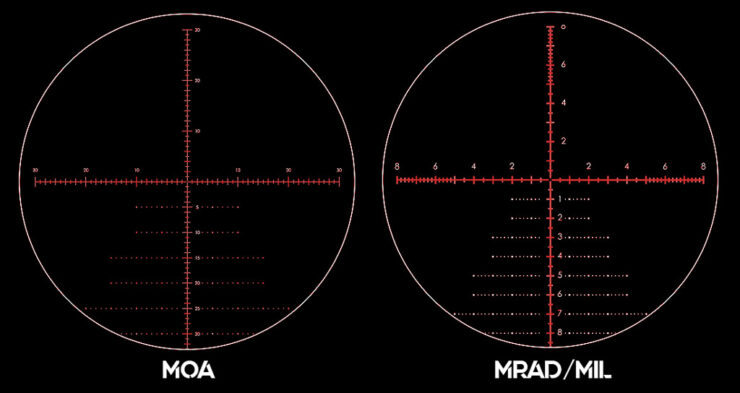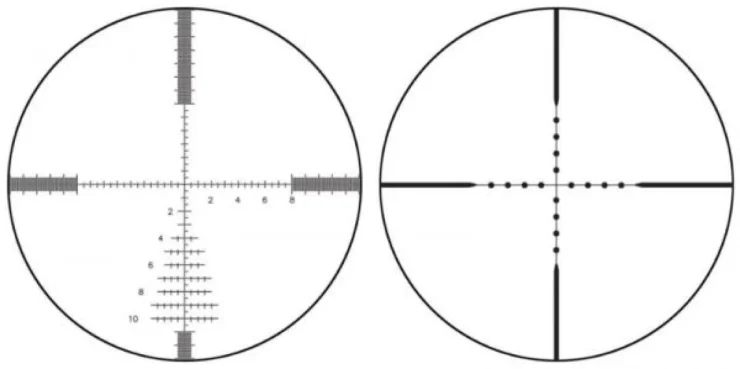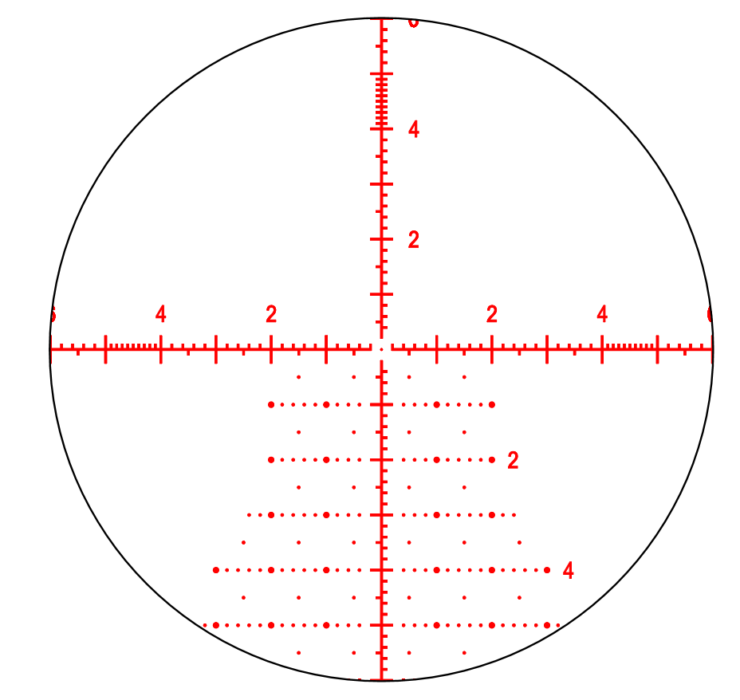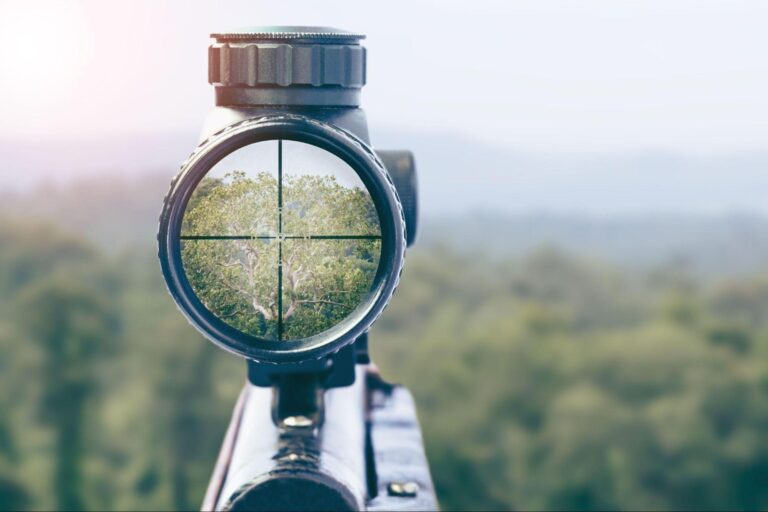If you’re looking to get a scope for your hunting rifle, you might have seen two types of reticles mentioned when it comes to calculating and making longer-range shots: MOA and MRAD.
These are two different systems of angular measure that are used to adjust how you angle your weapon, allowing you to make more effective shots across a further range.
Both have their advantages compared to each other and whichever one you pick will be up to personal preference and what you’re used to. Allow us to help you decide between the two.
What’s the Difference Between an MOA and an MRAD Scope?

MOA stands for Minute Of Angle or 1/60th of an angle. One MOA adjustment can have a difference of 1 inch at 100 yards.
On the other hand, milliradians, or MRAD, is used to define 0.001 radians of the rifle scope reticle. One MRAD dot adjustment will result in a 3.6-inch per 100-yard change.
These are two different measurement systems that aim to have the same function. Click here for a more in-depth guide on MOA vs. MRAD systems.
Advantages of MOA Scopes

MOA reticle scopes have unique advantages, especially if you’re used to the imperial measurement system. Here are a few advantages they have:
Better Precision at Close Range
MOA allows you to adjust more precisely if you’re hunting at close range. This means that if your gun is only capable of closer-range shots, this is a better option.
For example, a one-quarter MOA adjustment is a lot easier to make for close-range shooting than a 1/10 MIL adjustment on the MRAD reticle within 100 yards.
Making quick adjustments on the fly when hunting can mean the difference between getting the kill and missing out completely, which is why MOA is so useful in this context.
Better for Imperial Measurement Users
Another advantage to using MOA is that it’s easier to make adjustments if you’re used to measuring in inches and yards as opposed to centimeters and meters.
This is evident in the fact that 1 MOA adjustment will move the shot one inch at a 100-yard target. It’s a round number you can easily communicate to other MOA users.
It’s harder to convert using centimeters and meters to MOA than using inches and yards, which most Americans already use.
Advantages of MRAD Scopes

MRAD scopes are no slouches when it comes to hunting, either, even when compared to MOA scopes. There’s a reason that this is the system of choice for military and police equipment.
Compatible for Use With Most Holographic Sights
Most of the reflex and red dot sights available on the market have 1 MIL reticles, if any. This means any adjustments you’ll make on them will be using the MRAD system.
If you’re already using the MRAD system on your rifle scope, it would be a lot easier to carry that over for use with red dots as opposed to MOA.
For example, if you have a hunting sidearm like a pistol with a red dot on it, you’ll only need to remember one system of adjustment instead of two.
Easier for Long Range Adjustments
The MRAD system can be adjusted in 1/10 clicks. This means that there’s a finer level of adjustment that you can make to really dial in longer-range shots.
Turrets on MRAD scopes usually have 0.1 MIL increment adjustments, meaning each click only makes a 0.36-inch adjustment every 100 yards.
While MOA is faster for close-range shots, it sacrifices a bit of precision. When it’s time to shoot at longer ranges, MRAD has more incremental and accurate adjustments that can spell the difference between hitting or missing.
Better for Metric System Users
If you’re using the metric system (centimeters and meters) instead of the imperial system, then MRAD will be much easier for you to adapt to.
This is because 0.1 MRAD click adjustments move the shot exactly 1 centimeter per 100 meters, similar to how 1 MOA moves a shot 1 inch every 100 yards.
Both systems were created from the ground up for different measurement systems, so whichever one is better will come down to your personal preference.
More Tactical
One advantage to having the MRAD system is that the military and police use it in all their scopes. This means it’s a tried and tested system that’s been used in combat.
You’ll want every advantage you can get when you’re trying to either take down wild game or save your life from large predators attacking you.
While making more small adjustments than large simple ones seems intimidating, it is more accurate in practice. There’s a reason why police and military swear by it. It works.
Tips on Hunting With Rifle Scopes

Whether you choose MRAD or MOA scopes for your rifle, here are a few tips that can help you improve your shot and make your hunting experience better OVERALL.
- Get a variable zoom scope if you shoot in mixed close and long-range situations.
- Focus on getting the best optic glass quality when picking a scope.
- Practice frequently at the range before hunting to test the adjustment system.
- Always bring a sidearm like a handgun for personal protection.
- Install scope covers when not in use to protect the objective lens.
Frequently Asked Questions (FAQs)
After learning more about how MRAD and MOA scopes compare for hunting rifles, you might have more questions about the two systems.
Can You Use MOA and MRAD in One Scope?
While it’s possible to use both systems in one scope, it’s not recommended. This is because it’s confusing and hard to get used to. Transitioning between each system is also quite challenging to do on the fly.
Why Does the Military Use MRAD?
Police and military units use MRAD because of the system’s consistency over different engagement ranges. A MIL is the same at close range as it is at long range.
While making MIL adjustments at close range vs. MOA is less convenient, it’s still just as accurate. It just takes more clicks to adjust.
What Is the Most Popular Reticle for Hunting?
The most popular reticle for hunting is the Duplex-style reticle. The thick borders and thinner center make finding a target in a busy forest background easier without too many lines obstructing your view.
Final Thoughts
While MRAD and MOA have advantages and disadvantages, the choice of which one to get rests primarily on your preference and what measurement system you use.
If you’re a metric system user, get MRAD scopes. If you’re an imperial system user, then get MOA. That makes the learning process faster and less confusing.

